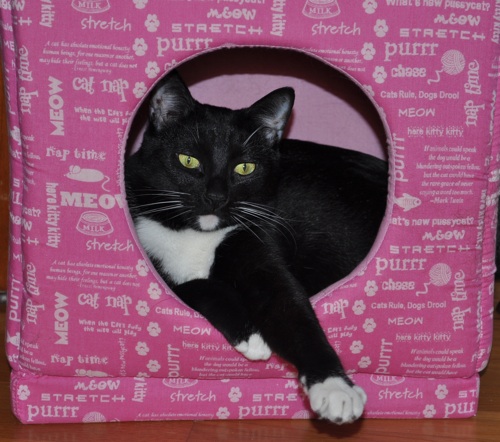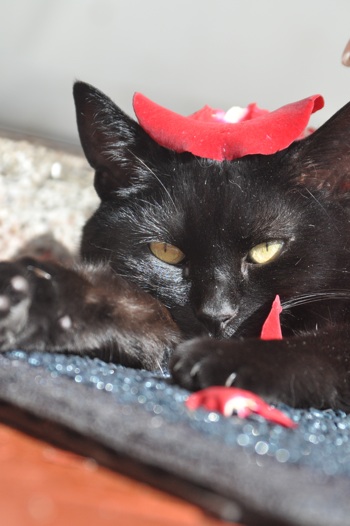Your cat will meet many people in her lifetime; meeting new people and saying goodbye may be difficult for her. However, there are some things you can do to make these events less stressful for her.
Vacation
 When you go away on vacation your cat either finds herself home alone or in a boarding kennel. Being boarded means not only is she in unfamiliar surroundings with unfamiliar people and animals but she is also removed from her normal schedule.
When you go away on vacation your cat either finds herself home alone or in a boarding kennel. Being boarded means not only is she in unfamiliar surroundings with unfamiliar people and animals but she is also removed from her normal schedule.
Hiring a pet sitter to come to your home and stay with the cat or visit your home daily is a good alternative. If you decide to hire a pet sitter, introduce him or her to the cat a few weeks ahead of your vacation. If possible, set up a couple of "play-dates" so that you, your cat, and the sitter can get to know each other. Playtime interaction that includes food treats can help to establish a positive relationship between the cat and the sitter. In other words, if your cat associates the sitter with playtime and treats, she will be glad to see her! You should also make sure the sitter is familiar with your cat's daily routine. Try to make a list that includes what time of day you usually feed the cat, scoop the litter, and have playtime or petting and grooming time with the cat.
Establishing a refuge will be helpful to give the cat a safe, familiar place to go while she is alone. A piece of clothing or a blanket with your scent on it will help calm the cat and make her feel that you are nearby. Leave a radio or TV playing near the refuge to provide calming "white noise".
New Person Moving In
Try to keep the cat's routine as normal as possible during this period of transition. Provide the cat with a refuge. Increase the amount of playtime or petting and grooming your cat receives to help reassure her. Involve the new person in play sessions with the cat. Playtime interaction that includes food treats can help to establish a positive relationship between the cat and the new person. Most importantly, allow the cat to investigate the new person and their belongings at her own pace. Each cat adjusts at a different pace and it may take time for her to get used to the new person. Let the cat decide when she is comfortable.
Introducing Your New Baby
Bringing home a new baby is a hectic and exciting time for everyone in your household. Before the baby is born you can help ease the transition for your cat by getting her used to the sounds and smells associated with babies. You may want to start using small amounts of baby lotion, baby oil and baby powder on your own skin so that the cat gets accustomed to the scent and associates it with you. Playing a tape recording of an infant's cry will help get your cat used to a soon to be familiar sound in your home. Have a friend with a baby visit so your cat will get used to the sight, smell and sound of a baby.

When preparing the nursery, allow plenty of time so that the cat can get used to it. Provide the cat with a refuge while you are working on the nursery. Leave a TV or radio on in the refuge. Let the cat explore the new room at her own pace and maintain her refuge so that she can return to a familiar place when she needs to.
Make the crib undesirable to the cat by placing empty soda cans in it. Cans are uncomfortable to lie down on and will rattle if the cat jumps in. The cat will associate the unpleasant noise with the crib, not you. Alternatively, a crib net may be placed over the crib to keep the cat out. Pull netting tight to keep the cat from using it as a hammock.
When the baby arrives, try to keep the cat's routine as normal as possible. Increase the amount of playtime or petting and grooming your cat receives from family members to reassure her. Your cat will be curious about the baby. Let her see and smell the baby while you supervise carefully. The cat may want to be near you when you hold or nurse the baby. Let the cat sit beside you or have someone offer her treats or playtime while you are busy with the baby. Allow yourself time daily to play with your cat.
Temporary Absence of Primary Caretaker
Keep the cat at home if possible. Have other family members spend more time interacting with the cat. Establishing a refuge will be helpful to give the cat a safe, familiar place to go while you are gone. A piece of clothing or a blanket with your scent on it will help calm the cat and make her feel that you are nearby. Leave a radio or TV playing near the refuge to provide calming" white noise".
Familiar Person Leaving
Try to keep the cat's routine as normal as possible during this period of transition. Provide the cat with a refuge. Increase the amount of playtime or petting and grooming your cat receives to help reassure her.
Death of a Human or Animal Family Member
Cats, like people, take time to adjust to loss. They go through the same stages of grief that humans do. Your cat may experience loss of appetite, become anxious or depressed, behave inappropriately and become more vocal. Don't attempt to punish your cat for changes in her behavior at this time. Try to keep her routine as normal as possible during this period of transition. Provide her with a refuge and increase the amount of playtime or petting and grooming she receives to help reassure her.
If the deceased was the cat's primary caretaker an article of clothing that belonged to that person can be placed in the cat's refuge. Ideally the new caretaker should be someone the cat is familiar with. If that is not possible and the cat needs to be re-located, the guidelines for moving the cat to a new home should be followed (see Moving to a New Home).
Entertaining Guests
Having new people in the home can be confusing and frightening for your cat. A refuge will help the cat feel safe and provide a place to for her to retreat to when household activities are hectic. Allow the cat to approach guests if she wants to but never force her to interact with new people. Make sure that guests respect the privacy of your cat’s refuge.

